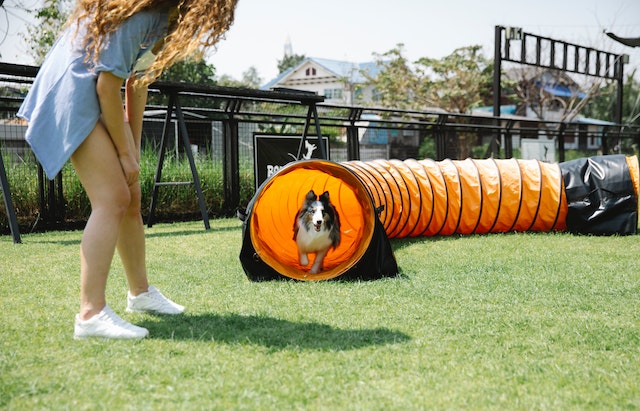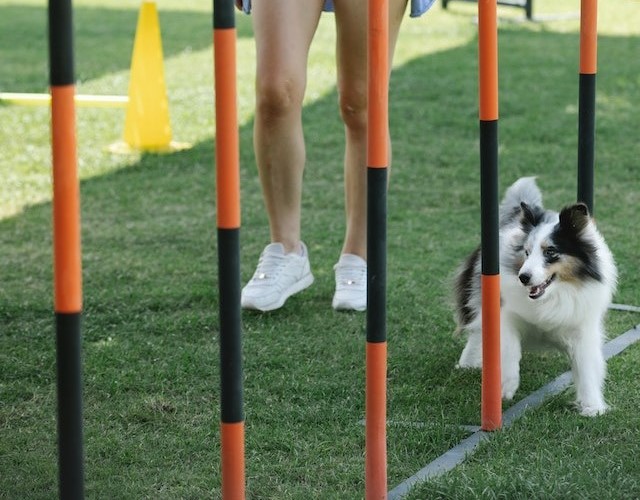I may earn a small commission if you purchase through the links 🙂
What is agility?
Agility training is a popular activity and competitive sport in which dogs run through a timed obstacle course with the guidance and direction of their handlers.
The handler guides and directs the dog through a variety of obstacles, and the goal is for the dog to complete the whole course correctly and in the fastest time possible. It's a form of exercise that is constantly gaining popularity, and it's suitable for people of all ages.
What is agility?
Agility is an obstacle course competition for dogs in which the handler guides the dog through the course designed by the judge flawlessly and as quickly as possible without touching the dog or the obstacles.
The sport is based on human-dog cooperation so it requires a strong bond between the dog and the handler, as well as efficient communication and teamwork.
What does agility involve?
Agility training involves teaching your dog to follow commands, navigate obstacles, keep his focus, and react while running through the course.
It involves training each obstacle in different steps and teaching the dog to perform each obstacle separately. The handler teaches the dog to follow verbal commands, hand signals, and the handler’s body language and movement, so the dog can, later on, complete the course successfully.
While the dog learns to complete each obstacle individually and as he becomes more skilled, the level of difficulty level is gradually increased.
The most used agility training methods include clicker training and positive reinforcement.

What are the benefits of Agility?
Apart from being an entertaining and engaging sport, agility also provides a variety of other benefits for your dog and you!
It improves a dog’s obedience, it helps with his coordination and boosts his confidence. It also offers mental stimuli and physical exercise, and it helps with strengthening the bond between the dog and the handler.
Who is agility suitable for?
Agility training is a good hobby because it can be practiced by any one regardless of age.
It’s a popular sport among dog owners who want to engage in an active and fun activity with their companions.
If you want to compete you can also do that since, competitions are held at various levels. For example ranging from local events to international championships. Or if you just want to have fun with your dog, you don’t have to compete because it’s not a mandatory part of the sport.
Agility is also suitable for all breeds and sizes of dogs.
The most popular breeds seen in competitions are border Collies, sheepdogs, and small terriers.
However, it’s important to consider a dog’s age, health, and physical condition, and whether he has behavior issues before starting agility training to ensure it’s suitable for the dog. It’s always recommended that you consult a veterinarian about whether it’s an appropriate hobby for your dog.
What are the obstacles like?
Agility training courses consist of various obstacles such as jumps, tunnels, weave poles, A-frames, seesaws, and more. The specific obstacles and their arrangement on the course can vary depending on the training session or the competition.

How to start agility?
If you’re interested in starting agility training, I recommend researching local training facilities or clubs near you that offer agility classes. Many dog training centers and clubs provide guidance, resources, classes, and competitions for all breeds and sizes of dogs.
You can also do it at home!
All you need to do is gather information and get obstacles for your backyard. Of course, a large yard is also useful.
Equipment you need for an agility practise
If you decide to attend an agility class, you’ll be going to need:
If you want to learn more about a treat dispenser and why it is great for agility training click here
- a toy
- water bowl
- water bottle with fresh water
- training vest or pouch
- a clicker
It’s good to always have treats and a toy near you when training with your dog because you can reward your dog with them. That’s why you need a training vest or pouch. When you have a training vest or pouch on you during a training session, you can quickly reward your dog by simply taking a treat or a toy from your pocket.
Why do you need a clicker? In any training, a clicker can be a valuable tool if the training for it has been done correctly because it offers clear communication, quick feedback, and positive reinforcement. To get all the benefits from the clicker, you must learn to use it effectively. With proper timing, consistency, and pairing the clicks with rewards, you are on the right track with using the clicker.
- Clicking With Your Dog: Step-By-Step Book
- Clicker Training For Dogs: Positive Reinforcement That Works
Why do I recommend a treat dispenser? A treat dispenser is great for agility training because you can reward your dog from a distance and it makes the training session more efficient because you don’t always have to go back and forth feeding your dog.
It’s always important to have fresh drinking water available for your dog during training sessions. This ensures that your dog stays hydrated and can keep up with the training!
Obstacles you need at home
Related books

So if you’re looking for a new hobby you can do with your furry friend, try agility!
Hey Linda! My puppy is 9 months old. When can we start agility?
Hey Stacy!
Thank you for asking! This is a really important question.
Many professionals and dog trainers say it’s wise to wait, until your dog’s growth plates have closed. It happens between the 12 to 24 months of age. Before starting intense agility training, you should instead teach your dog basic commands and do strengthening exercises with him. These help to prevent any potential injuries.
Also, the breed, size, and individual development of your buddy, affect when you can start practicing agility more intensely.
It’s also smart to consult a professional dog trainer or agility instructor who can tell you when to start agility training with your specific dog breed and according to individual circumstances.
-Linda